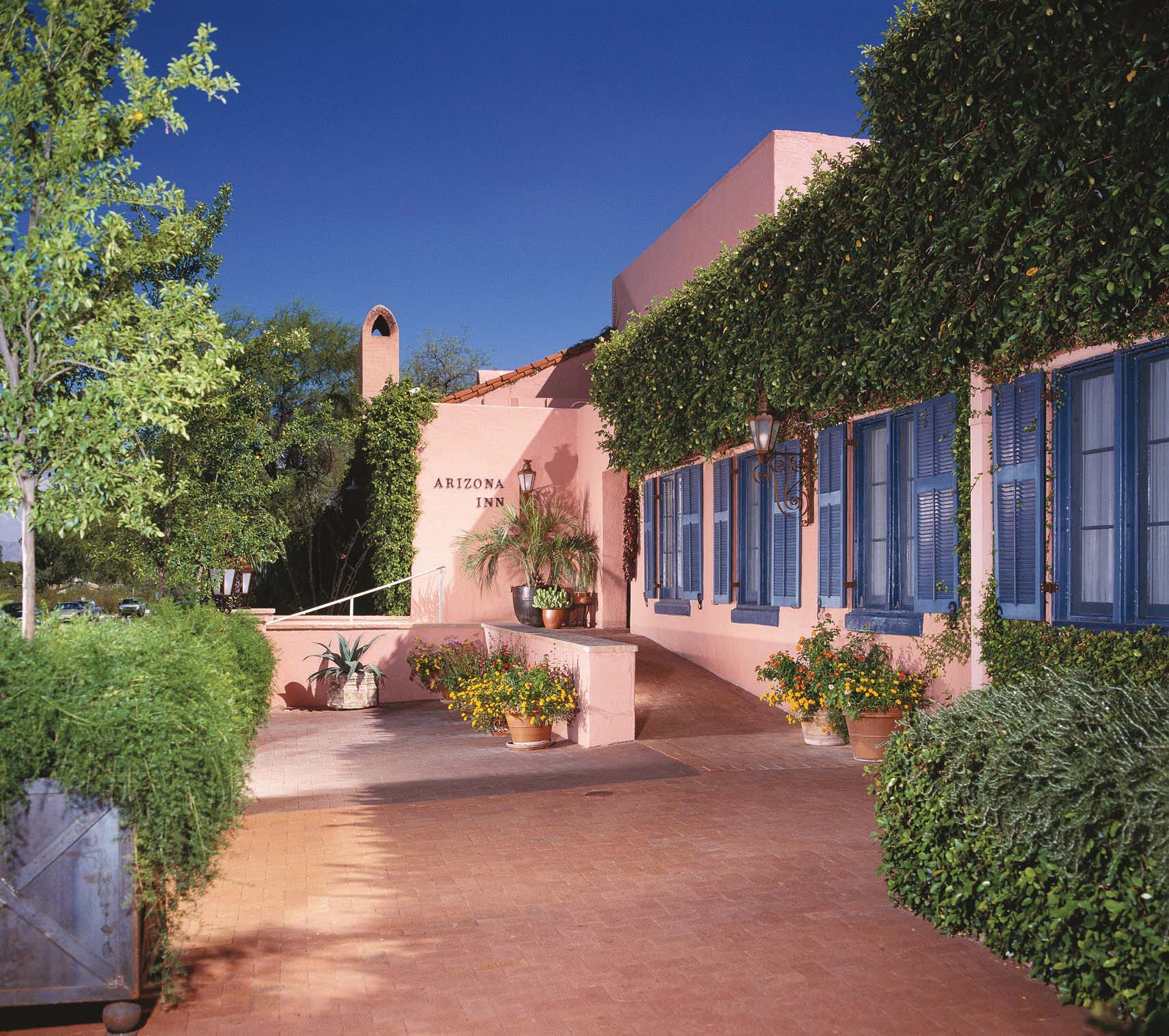
31 Oct WESTERN LANDMARK: SOLITUDE AND SUNSHINE AT TUCSON’S ARIZONA INN
The Arizona Inn opened on December 18, 1930, with a dinner and dance attended by a select group of couples from the nearby University of Arizona. In four years, the establishment’s founder and owner, Isabella Greenway [1886–1953], would be sworn in as the first congresswoman in the state’s history, continuing an important legacy of public service. During the inn’s opening reception, Greenway declared it, “A simple, home-like, cottage hotel, complete in its luxuries and convenience of service, and built with the desire to give its guests privacy, quiet, and sunshine.” Those three principles would be a guiding vision for decades as the family steered the property through additions and improvements, judiciously restoring the first generation of buildings.
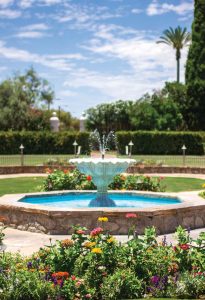
The inn’s “Wedding Fountain” was positioned so a bride could appear through the opening in the hedges, meeting her groom just shy of the fountain, surrounded by beds of brightly colored flowers. | Photo courtesy of the Arizona Inn
At the time of the inn’s founding, Arizona had become a respite for the wealthy of the Midwest and East, who traveled West by train to exchange bitter cold winters for months in the sunshine, spending much of their time outdoors as daytime temperatures could reach into the 80s. Other resorts with a similar purpose that opened during this period were the Arizona Biltmore (1929) in Phoenix and La Posada Hotel (1930) in Winslow, Arizona.

The pool at the Arizona Inn was constructed in 1937 and was recently resurfaced. The two-story building was built near the end of World War II to house military personnel; later, seasonal hotel staff lived there, and now it hosts the men’s and women’s locker rooms along with four guest rooms. | Photo courtesy of the Arizona Inn
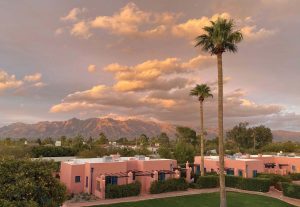
When the inn opened in 1930, there were four original buildings and a total of 22 rooms; additional rooms were added in 1931. | Photo courtesy of the Arizona Inn
In keeping with this history as a restorative locale, a group of veterans was recovering in Tucson from lung injuries received during World War I. These men played a vital role in establishing the Arizona Inn; in fact, the current president and manager of the inn, Will Conroy, says they were its heart and soul.
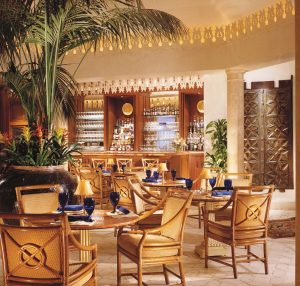
The Audubon Bar and Patio, named for the artist’s nature prints on its walls, was a gathering place after prohibition ended and was often visited by celebrities, including actress Katharine Hepburn and actors Spencer Tracy, James Stewart, Cary Grant, and John Wayne, among others. Architect Frank Lloyd Wright reportedly said the lounge was one of the finest rooms he’d ever visited. | Photo courtesy of the Arizona Inn
Greenway’s dedication to veterans had begun some years earlier when she and her daughter Martha toured the Pastime Park Veterans Hospital, Tucson’s first veterans’ hospital and a sanitorium for those recovering from respiratory diseases received during World War I. While there, they saw that many of these men could not work due to exposure to gas in the trenches of war. Martha noted that some veterans were carving wood as a pastime and were quite good at it. This observation led to the founding in 1927 of The Arizona Hut, a workshop that employed disabled veterans who were convalescing in Tucson. With training, these veterans became expert furniture makers, selling to upscale merchants like Abercrombie & Fitch and Marshall Field’s. The group, having grown from 40 participants to over 100 by 1929, was making everything for a home except the carpet and appliances. However, the stock market crash and the succeeding Great Depression threatened their business. The Hut, a doughboy’s slang for “a refuge from the front,” needed a solution.
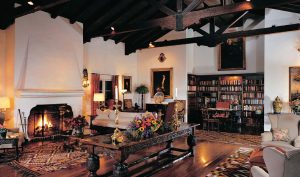
Many consider the inn’s library their favorite room, with portraits of Isabella Greenway and her first husband, Robert H.M. Ferguson. The couch and three-legged lamps are original pieces from The Hut. | Photo courtesy of the Arizona Inn
In response, Greenway founded the Arizona Inn to create demand for The Hut’s furniture and keep the veterans employed. Their goods would furnish the new hotel with tables and chairs for the dining room and all the furnishings in a suite. Original Arizona Hut furniture can be found around the inn today, maintained and cared for by the on-site carpentry shop.
Greenway was a woman of distinction, great courage, and character. She was friends with the Roosevelt family and was a bridesmaid at Franklin and Eleanor’s wedding. Her first two husbands, each of whom died, volunteered as Theodore Roosevelt’s “Rough Riders” during the Spanish-American War.
In 1910, Greenway moved her family to the Burro Mountains outside of Silver City, New Mexico, to help her first husband recover from tuberculosis. There, she homesteaded and ran cattle for 12 years. She also founded the New Mexico Women’s Land Army during World War I, which recruited women to work on farms and ranches while men were at war.
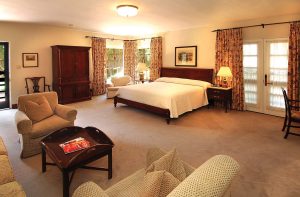
This suite is among the rooms added during the summer of 1931. | Photo courtesy of the Arizona Inn
She moved to Tucson in 1926 after her second husband, John Greenway, died. While there, she owned and oversaw the Quarter Circle Double X Ranch, growing the operation to more than 130,000 acres. She also ran a charter airline company based in Los Angeles, Gilpin Airlines.
In 1928, Greenway became Arizona’s Democratic national committeewoman, playing a key role in reorganizing the Democratic Party so the men’s and women’s divisions were integrated. This ensured that women were more actively involved in the political process. A few years later, in 1934, she was sworn in as the Democratic Representative to the 73rd Congress, winning the seat with 70 percent of the vote to become the state’s first congresswoman.
In 1988 the Arizona Inn was listed on the National Register of Historic Places. The Arizona Historic American Landscape Survey states that Greenway was “personally involved in the selection of every element of the Mediterranean and Spanish Colonial Revival-style Arizona Inn. This attention to detail manifested itself in the final design and layout of the hotel site, from the orientation of the individual buildings in such a way as to create interior, protected communal spaces and courtyards, to the borrowing of ideas from Spanish gardens, to choosing specific plantings to provide shade and privacy. Mrs. Greenway’s attention to detail was echoed in the motto of her business — a place of privacy and tranquility.”
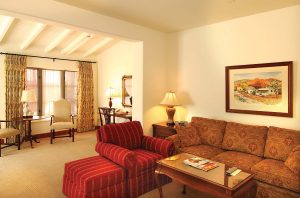
The Deluxe Patio Suite is the largest available room at the inn, with a bedroom, sitting room, and hallway. Every suite has a private patio, as Isabella Greenway deemed it necessary. | Photo courtesy of the Arizona Inn
Greenway chose Tucson architect Merritt H. Starkweather [1891–1972] to design the inn, which exemplified the finest of materials and construction. Its walls were constructed of thick columns of red brick that are spaced an inch-and-a-half apart for insulation. Oak timbers from the nearby Santa Rita Mountains and stone columns from Indian Hot Springs near Safford, Arizona, were used in some buildings. Beneath the inn, a unique system of tunnels protected its water supply. Teakwood floors in the dining room are fastened by pegs and caulked, and the floors are triple-layered so that guests are never disturbed by creaks.
Landscape architect James Oliphant planted native cactus and European-style gardens at Greenway’s behest. Today, the Arizona Inn’s grounds are a park-like setting, an oasis in the desert. Expanses of green spaces host croquet and badminton, and the pool and tennis courts that the family added in 1937 have been upgraded. Plantings around the property have grown, forming secluded spots for guests, an intention Greenway had from the beginning when she said she wanted to create spaces where “guests had privacy, quiet, and sunshine.”
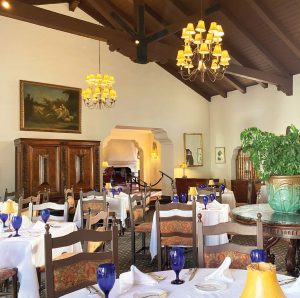
The primary dining room is a part of the original building. The tables are original from The Hut, while the chairs were recreations updated to accommodate modern body-sizes. The original chairs had caning on the seats, added by students at Tucson’s School for the Deaf and Blind in 1930. | Photo courtesy of the Arizona Inn
Now in its 94th year, the Arizona Inn has always operated as a family business and continues to do so. Greenway’s great-grandson Will Conroy is now serving his 25th year after following in the footsteps of his great-uncle, John “Uncle Jack” Greenway, who ran the inn for over 40 years. Conroy’s mother, Frances “Patty” Doar, lives nearby and has been a hero there for many decades, serving as its general manager during the 1980s and 1990s.
“Its buildings are as solid and quiet as primeval boulders,” says Conroy, “and the flowerbeds and trees Isabella so thoughtfully laid out over 90 years ago have grown and twisted happily into their maturity. Its 14 acres of grounds and gardens have provided ever more peace and quiet as well as fruit and shade as the 20th century has yielded to the 21st century. The Arizona Inn continues to attract visitors from around the world to find respite under the Arizona sun.”
WA&A senior contributing editor Shari Morrison has been in the business of art for more than 40 years. She helped found the Scottsdale Artists’ School and the American Women Artists and directed the Santa Fe Artists’ Medical Fund for some years.






No Comments